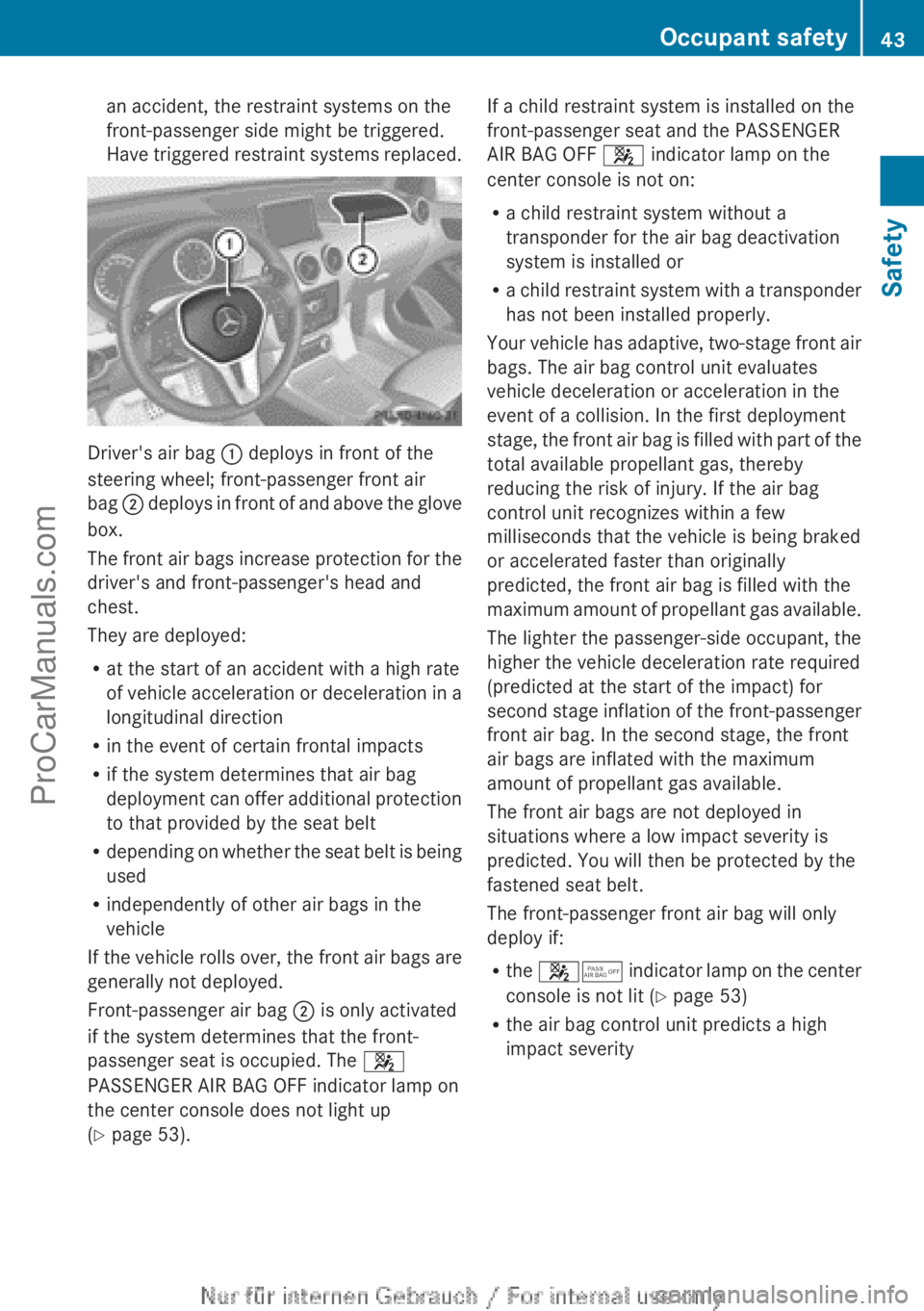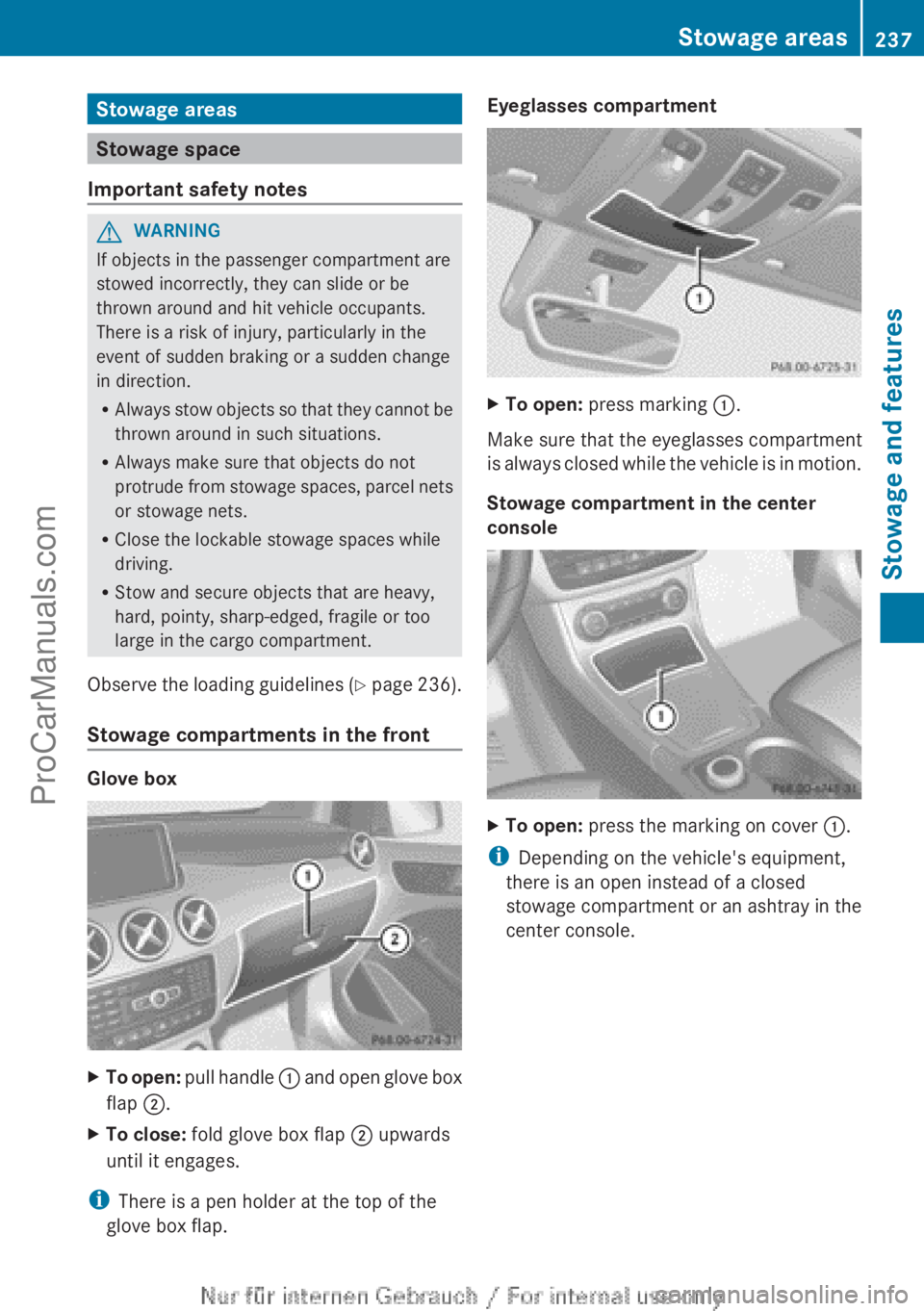2012 MERCEDES-BENZ B-CLASS glove box
[x] Cancel search: glove boxPage 12 of 340

Preparing the vehicle
.....................281
TIREFIT kit ...................................... 282
see Emergency spare wheel
Floormats ........................................... 264
Fog lamps Extended range .............................. 102
Switching on/off .............................. 99
Folding table ...................................... 239
Front fog lamps Display message ............................ 210
Switching on/off .............................. 99
Front-passenger seat
Folding the backrest forward/back 239
Fuel
Additives ........................................ 331
Consumption statistics ..................189
Displaying the current
consumption .................................. 190
Displaying the range ...................... 190
Driving tips .................................... 152
Fuel gauge ....................................... 29
Grade (gasoline) ............................ 330
Important safety notes .................. 330
Premium-grade unleaded gasoline . 330
Problem (malfunction) ...................149
Refueling ........................................ 147
Tank content/reserve fuel .............330
Fuel filler flap
Opening/closing ............................ 148
Fuel level
Calling up the range (on-board
computer) ...................................... 190
Fuel tank
Capacity ........................................ 330
Problem (malfunction) ...................149
Fuses
Allocation chart ............................. 295
Before changing ............................. 294
Fuse box in the engine
compartment ................................. 294
Fuse box in the front-passenger
footwell .......................................... 295
Important safety notes .................. 294 G
Garage door opener Clearing the memory ..................... 263
Important safety notes
..................260
Opening/closing the garage door ..262
Programming (button in the rear-
view mirror) ................................... 260
Gear or selector lever (cleaning
guidelines) ......................................... 276
Genuine parts ...................................... 20
Glove box ........................................... 237 H
Handbrake see Parking brake
Hazard warning lamps ......................101
Display message ............................ 223
Headlamps
Adding fluid to cleaning system .....269
Cleaning system (function) ............ 101
Cleaning system (notes) ................334
Fogging up ..................................... 103
see Automatic headlamp mode
Head restraints
Adjusting ......................................... 89
Adjusting (electrically) .....................89
Adjusting (manually) ........................ 89
Adjusting (rear) ................................ 90
Installing/removing (rear) ................ 90
Heating
see Climate control
High-beam headlamps
Changing bulbs .............................. 107
Display message ............................ 210
Switching Adaptive Highbeam
Assist on/off ................................. 102
Switching on/off ........................... 100
Hill start assist .................................. 136
HOLD function Deactivating ................................... 168
Display message ............................ 215
Function/notes ............................. 168
Hood
Closing ........................................... 267
Display message ............................ 22210
Index
ProCarManuals.com
Page 18 of 340

SRS (Supplemental Restraint
System)
Display message ............................ 207
Introduction
..................................... 38
Warning lamp ................................. 230
Warning lamp (function) ................... 39
Standing lamps
Changing bulbs .............................. 108
Display message ............................ 210
Switching on/off ........................... 100
Start/stop function
see ECO start/stop function
Starting (engine) ................................ 135
STEER CONTROL .................................. 64
Steering (display message) ..............222
Steering wheel Adjusting (manually) ........................ 91
Button overview ............................... 31
Buttons (on-board computer) ......... 187
Cleaning ......................................... 276
Important safety notes .................... 91
Paddle shifters ............................... 144
Steering wheel paddle shifters ........144
Stowage areas ................................... 237
Stowage compartments Armrest (front) ............................... 238
Armrest (under) ............................. 238
Center console .............................. 237
Cup holders ................................... 247
Eyeglasses compartment ............... 237
Glove box ....................................... 237
Important safety information ......... 237
Parcel net ...................................... 239
Under driver's seat/front-
passenger seat .............................. 238
Stowage space
Center console (rear) ..................... 238
Summer tires ..................................... 300
Sun visor ............................................ 249
Supplemental Restraint System see SRS (Supplemental Restraint
System)
Surround lighting (on-board
computer) .......................................... 198
Switching air-recirculation mode
on/off ................................................. 129
Switching off the alarm (ATA) ............65 T
Tachometer ........................................ 187
Tailgate Display message ............................ 222
Emergency unlocking .......................76
Important safety notes
....................75
Opening/closing (from outside) ....... 76
Opening dimensions ...................... 335
Tail lamps
Display message ............................ 210
see Lights
Tank content
Fuel gauge ....................................... 29
Technical data
Capacities ...................................... 329
Emergency spare wheel ................. 326
Information .................................... 328
Tires/wheels ................................. 323
Vehicle data ................................... 335
TELEAID
Call priority .................................... 255
Downloading destinations
(COMAND) ..................................... 256
Downloading routes .......................259
Emergency call .............................. 253
Geo fencing ................................... 259
Important safety notes .................. 251
Locating a stolen vehicle ............... 258
MB info call button ........................ 255
Remote vehicle locking .................. 257
Roadside Assistance button .......... 254
Search & Send ............................... 256
Self-test ......................................... 252
Speed alert .................................... 259
System .......................................... 252
Triggering the vehicle alarm ........... 260
Vehicle remote malfunction
diagnosis ....................................... 258
Vehicle remote unlocking .............. 257
Telephone
Accepting a call ............................. 193
Display message ............................ 222
Menu (on-board computer) ............ 193
Number from the phone book ........ 194
Redialing ........................................ 194
Rejecting/ending a call ................. 19416
Index
ProCarManuals.com
Page 45 of 340

an accident, the restraint systems on the
front-passenger side might be triggered.
Have triggered
restraint
systems replaced.Driver's air bag
: deploys in front of the
steering wheel; front-passenger front air
bag ; deploys in
front of and above the glove
box.
The front air bags increase protection for the
driver's and front-passenger's head and
chest.
They are deployed:
R at the start of an accident with a high rate
of vehicle acceleration or deceleration in a
longitudinal direction
R in the event of certain frontal impacts
R if the system determines that air bag
deployment can offer additional protection
to that provided by the seat belt
R depending on whether the seat belt is being
used
R independently of other air bags in the
vehicle
If the vehicle rolls over, the front air bags are
generally not deployed.
Front-passenger air bag ; is only activated
if the system determines that the front-
passenger seat is occupied. The 4
PASSENGER AIR BAG OFF indicator lamp on
the center console does not light up
(Y page 53). If a child restraint system is installed on the
front-passenger seat and the PASSENGER
AIR BAG OFF
4 indicator lamp on the
center console is not on:
R a child restraint system without a
transponder for the air bag deactivation
system is installed or
R a child
restraint
system with a transponder
has not been installed properly.
Your vehicle has adaptive, two-stage front air
bags. The air bag control unit evaluates
vehicle deceleration or acceleration in the
event of a collision. In the first deployment
stage, the front air bag is filled with part of the
total available propellant gas, thereby
reducing the risk of injury. If the air bag
control unit recognizes within a few
milliseconds that the vehicle is being braked
or accelerated faster than originally
predicted, the front air bag is filled with the
maximum amount of propellant gas available.
The lighter the passenger-side occupant, the
higher the vehicle deceleration rate required
(predicted at the start of the impact) for
second stage inflation of the front-passenger
front air bag. In the second stage, the front
air bags are inflated with the maximum
amount of propellant gas available.
The front air bags are not deployed in
situations where a low impact severity is
predicted. You will then be protected by the
fastened seat belt.
The front-passenger front air bag will only
deploy if:
R the 45 indicator lamp on the center
console is not lit (Y page 53)
R the air bag control unit predicts a high
impact severity Occupant safety
43
Safety Z
ProCarManuals.com
Page 157 of 340

brake pads. This can result in a significantly
longer braking distance.
R
Brake occasionally to
remove any possible
salt residue. Make sure that you do not
endanger other road users when doing so.
R Carefully depress the brake pedal and the
beginning and end of a journey.
R Maintain a greater distance to the vehicle
ahead.
Servicing the brakes !
If the red
brake warning lamp lights up in
the instrument cluster and you hear a
warning tone while the engine is running,
the brake fluid level may be too low.
Observe additional warning messages in
the multifunction display.
The brake fluid level may be too low due to
brake pad wear or leaking brake lines.
Have the brake system checked
immediately. This work should be carried
out at a qualified specialist workshop.
! A function or performance test should
only be carried out on a 2-axle
dynamometer. If you are planning to have
the vehicle tested on such a dynamometer,
contact an authorized Mercedes-Benz
Center to obtain further information first.
Otherwise, you could damage the drive
train or the brake system.
! As the ESP ®
system operates
automatically, the engine and the ignition
must be switched off (the SmartKey must
be in position 0 or 1 in the ignition lock) if:
R the electric parking brake is tested on a
brake dynamometer (for a maximum of
ten seconds)
R the vehicle is towed with the front axle
raised.
Braking triggered automatically by ESP ®
may seriously damage the brake system.
All checks and maintenance work on the
brake system must be carried out at a qualified specialist workshop. Consult a
qualified
specialist workshop
to arrange this.
Have brake pads installed and brake fluid
replaced at a qualified specialist workshop.
If the brake system has only been subject to
moderate loads, you should test the
functionality of your brakes at regular
intervals.
You can find a description of Brake Assist
(BAS) on ( Y page 59).
Mercedes-Benz recommends that you only
have brake pads/linings installed on your
vehicle which have been approved for
Mercedes-Benz vehicles or which correspond
to an equivalent quality standard. Brake
pads/linings which have not been approved
for Mercedes-Benz vehicles or which are not
of an equivalent quality could affect your
vehicle's operating safety.
Mercedes-Benz recommends that you only
use brake fluid that has been specially
approved for your vehicle by Mercedes-Benz,
or which corresponds to an equivalent quality
standard. Brake fluid which has not been
approved for Mercedes-Benz vehicles or
which is not of an equivalent quality could
affect your vehicle's operating safety.
Checking brake lining thickness You can measure the break pad/lining
thickness using a test gauge. Color-coding
(green or
red)
on the test gauge allows you to
determine whether the brake pad/lining
thickness is still sufficient. The test gauge is
in the vehicle document wallet in the glove
box. Driving tips
155
Driving and parking Z
ProCarManuals.com
Page 239 of 340

Stowage areas
Stowage space
Important safety notes G
WARNING
If objects in the passenger compartment are
stowed incorrectly, they can slide or be
thrown around and hit vehicle occupants.
There is a risk of injury, particularly in the
event of sudden braking or a sudden change
in direction.
R Always stow objects
so that they cannot be
thrown around in such situations.
R Always make sure that objects do not
protrude from stowage spaces, parcel nets
or stowage nets.
R Close the lockable stowage spaces while
driving.
R Stow and secure objects that are heavy,
hard, pointy, sharp-edged, fragile or too
large in the cargo compartment.
Observe the loading guidelines (Y page 236).
Stowage compartments in the front Glove box
X
To open: pull handle :
and open glove box
flap ;.
X To close: fold glove box flap ; upwards
until it engages.
i There is a pen holder at the top of the
glove box flap. Eyeglasses compartment
X
To open: press marking :.
Make sure that the eyeglasses compartment
is always closed
while the vehicle is in motion.
Stowage compartment in the center
console X
To open: press the marking on cover :.
i Depending on the vehicle's equipment,
there is an open instead of a closed
stowage compartment or
an ashtray in the
center console. Stowage areas
237
Stowage and features Z
ProCarManuals.com